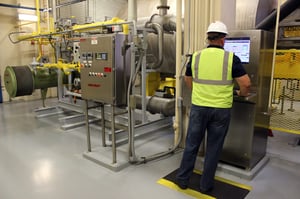Understanding Maintenance Metrics
While it’s technically possible to maintain a facility, property or asset portfolio without tracking specific metrics, it certainly is harder! In the age of technology, we are surrounded by data and devices that work to make our lives easier and more personalized, and maintenance software is no different. Here are some key performance indicators (KPIs) and other metrics you should be tracking to get the most out of your maintenance:
.png?width=300&name=Maintenance%20Metrics468%20x%2060%20(1).png) Overall Equipment Effectiveness (OEE)
Overall Equipment Effectiveness (OEE)
This metric measures the productivity of an asset, typically a piece of machinery or manufacturing equipment. Observing trends in this data over time can help you understand how effective your maintenance processes are, monitor asset availability, etc.
Understanding the reasons behind a less than 100% OEE can help your organization gain insights into pain points in the maintenance process, improve their MTBF, extend asset lifespans and complete other productivity-oriented goals.
There are two formulas for calculating this metric. OEE = availability x performance x quality is the most straightforward, but you may not have access to those base numbers without an OEE monitoring solution like a CMMS. The other is OEE = (Good Count x Ideal Cycle Time) / Planned Production Time. This version is available to all types of users, with or without a software solution.

Planned Maintenance Percentage (PPC)
Most organizations have some kind of planned maintenance procedure in place — it makes the most sense and has been proven to extend asset lifespans and improve asset uptime. PPC helps users calculate the percentage of planned vs. unplanned maintenance that is being performed.
This helps users track how much maintenance performed on individual assets is part of the preventive maintenance (PM) plan and how much is unexpected repair work because it broke down. In an ideal system, upwards of 90% of maintenance should be planned.
The calculation to determine this metric is: PPC = (scheduled maintenance time / total maintenance hours) x 100.
Mean Time Between Failure (MTBF)
MTBF refers to the predicted time between breakdowns during normal operations. It can help users forecast asset lifespans — longer MTBF means an asset is expected to last a long time before it breaks down.
Knowing how long a part or asset is expected to last can help with budgeting, PM plans, labor allocation and many other general tasks. Condition monitoring performed by CMMS software can help managers get an incredibly detailed understanding of the wear and tear on asset parts and perform predictive maintenance only when assets are nearing this failure point.
The formula for this calculation is: MTBF = Sum of asset uptime / total number of failures.
Mean Time to Repair (MTTR)
This metric tracks how long it takes to repair an asset to get it operational again. This includes time spent identifying the issue, repairing the asset, testing it and getting it back up to normal operation. The goal for this metric is for it to be as small as possible — every moment a critical asset like a manufacturing machine or wind turbine is down, your organization is losing money.
To calculate MTTR, use this formula: MTTR = sum of downtime / number of times repairs need to be performed.
 Preventive Maintenance Compliance (PMC)
Preventive Maintenance Compliance (PMC)
PMC is found by identifying what percentage of preventive maintenance work is completed during a set interval of time. This is used to monitor technician efficiency and set goals as well as realistic maintenance plans.
This equation is: PMC = (completed work orders/ expected work orders) x 100.
For example, if your organization’s PM plan allocated 82 work orders for the month, but because of a spike in unplanned maintenance your employees only completed 70 of them. It would look like this: (70/82) x 100 = 85.36%. This means that you performed 85% of your work orders for the month. To make this metric more meaningful, you should also track how many of them were completed on time at a narrower scale than monthly or yearly.
While these are by no means the only metrics you can track, they are the most crucial. Now you should be able to proceed with confidence in your maintenance metric tracking and calculations and well on your way to making your organization more data-driven.


